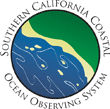About COCMP
The COCMP project ended in 2010. Surface Current observations in California are currently funded by the Integrated Ocean Observing System and operated by the Central & Northern California Ocean Observing System (CeNCOOS) and the Southern California Coastal Ocean Observing System (SCCOOS).
The Coastal Oceans Currents Monitoring Program (COCMP) was a multi-institution, interagency collaboration with the goal of integrated monitoring of currents in the coastal ocean. COCMP emphasized technology to measure and map surface currents.
Although the ocean influences climate, human health and many of our activities, predicting and detecting changes is difficult. Our knowledge of weather, and its importance to us, is far ahead of our understanding of the many important ways changing ocean conditions affect our lives. Knowledge of the coastal ocean is a scientific frontier with both international and national programs gathering new information. COCMP was a component of a nationwide effort to advance understanding of the ocean by developing long-term observing systems – the Integrated Ocean Observing System (NOAA IOOS). Change in the coastal ocean reflects variation on different scales of space and time. Both proven and emerging technologies can monitor–in close to real-time–the physical and biological processes that drive change in the coastal ocean. By understanding this environmental variability, Californians can better manage their ocean resources.
"The IOOS [Integrated Ocean Observing System] will substantially advance our ability to observe, monitor, and forecast ocean conditions and will contribute significantly to global Earth observing capabilities. The information generated by the IOOS will have invaluable economic, societal, and environmental benefits, including improved warnings of coastal and health hazards, more efficient use of living and nonliving resources, safer marine operations, and a better understanding of climate change." - U.S. Commission on Ocean Policy, Preliminary Report
The primary COCMP goal was to provide essential information to agencies responsible for managing coastal water quality. However, COCMP core technologies supplied information about surface water movement, which also benefits other coastal and ocean concerns. The movement of the sea surface plays a central role in transporting inorganic and organic material (natural and pollutants) and distributing the larvae of marine animals. While the information from surface currents can be used to track and predict trajectories of oil or sewage spills, it can also be used to help:
- Manage marine fisheries
- Design marine parks and conservation areas
- Improve efforts to restore endangered salmon and steelhead runs
- Respond to natural hazards like storm surge and coastal erosion events
- Increase the precision in weather and climate forecasts
- Increase efficiency of maritime shipping
- Provide useful information for coast and ocean recreational uses, such as boating and surfing
- Coast Guard search and rescue operations
- Assess the impacts of global warming on coastal habitats
See Benefits >
The State Coastal Conservancy and the State Water Resources Control Board are provided initial funding, with $21 million from the California Clean Water, Clean Air, Safe Neighborhood Parks, and Coastal Protection Act of 2002 (Proposition 40) and the Water Security, Clean Drinking Water, Coastal and Beach Protection Act of 2002 (Proposition 50). COCMP partner institutions provided matching funds and cost sharing.
As the lead agency for COCMP, the Coastal Conservancy managed COCMP development through a Coastal Conservancy grants program. The Conservancy worked with two consortia to develop final plans for COCMP deployment, which took about five years after the final grants were awarded in October 2004. The two consortia are the Southern California Coastal Ocean Observation System (SCCOOS) and the Central and Northern California Ocean Observation System (CeNCOOS).
See COCMP partners >
Observing ocean currents entails installing a variety of remote sensing technologies to gather data, and then integrating that information. Instruments on shore, in the ocean and on satellites monitor surface and subsurface currents, sea surface temperature, salinity and chlorophyll (a measure of the productivity of plant plankton).
COCMP focused initially on technology to measure and map surface currents. Surface currents can be measured in several ways, and COCMP utilized an integrated set of high frequency radar systems. High frequency radar provides—in close to real-time—maps of large areas of the coastal ocean, which depict the complex, constantly changing surface currents.

![COCMP Reference Guide [PDF] COCMP Reference Guide](images/booklet.jpg)

